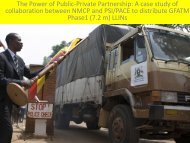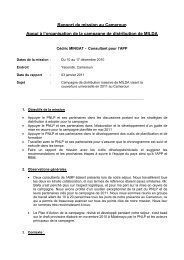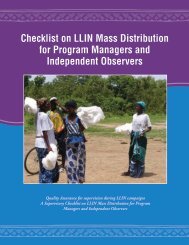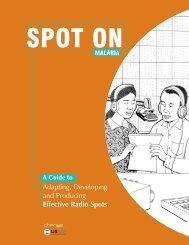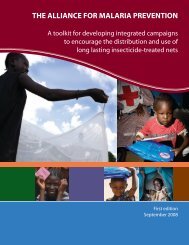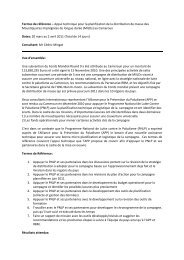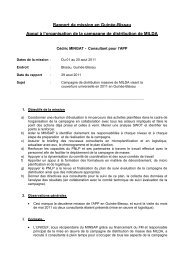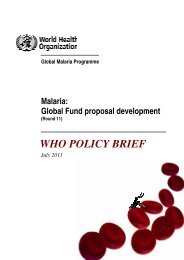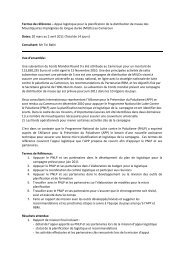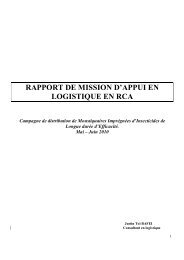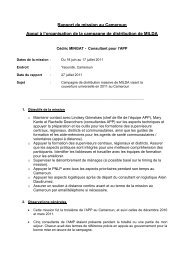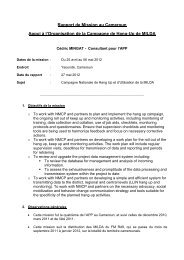Anambra State Post-Campaign Net Tracking Survey
Anambra State Post-Campaign Net Tracking Survey
Anambra State Post-Campaign Net Tracking Survey
You also want an ePaper? Increase the reach of your titles
YUMPU automatically turns print PDFs into web optimized ePapers that Google loves.
Executive Summary<br />
<strong>Anambra</strong> LLIN campaign evaluation<br />
As part of the evaluation of the Nigerian efforts in rapid scale up of ITN ownership and<br />
use in the country, a population representative household survey was undertaken in<br />
<strong>Anambra</strong> <strong>State</strong> in November 2009, at the end of the rainy season and approximately<br />
four months following the LLIN distribution campaign. The survey used the standard two<br />
stage cluster sampling design and produced data for 1012 households or 99.2% of the<br />
target.<br />
The major conclusions from this survey can be summarized as follows:<br />
• The LLIN distribution was successful in that it dramatically increased the coverage<br />
compared to the pre-campaign status; from 2.0% to 64.3% for ITN ownership.<br />
• Delivery of LLIN at the distribution points was very effective and equitable but there<br />
were some problems with the registration process that lead to only 80.0% of<br />
households being registered.<br />
• Estimates of the number of LLIN actually distributed based on the census data and<br />
survey estimates suggest that no significant leakage of LLIN from the campaign has<br />
occurred.<br />
• <strong>Net</strong> hanging was not very high with only 61.1% of campaign nets hanging but this was<br />
mainly due to motivational problems and nets not being needed rather than people not<br />
knowing how to hang the net as only 6.8% of households reported such difficulties in<br />
hanging.<br />
• Once the decision was taken to hang the net, use was good and nets were used very<br />
frequently suggesting that addressing the general motivation to use nets (net culture) is<br />
the main problem in <strong>Anambra</strong> <strong>State</strong>.<br />
• Achieved coverage with at least two LLIN per household – the national indicator for<br />
universal coverage – was quite high with 68.2%, but short of the 80% target. However,<br />
if the “one net for every two people” criteria was used, universal coverage was only<br />
42.9% and this is due to the limitation of two nets per household irrespective of<br />
household size.<br />
While there is evidence that the BCC component was effective in supporting net hanging and<br />
use, it was obviously lacking in intensity.<br />
The following summarizes key findings in more detail:<br />
Registration for LLIN<br />
Out of the 60 sampled clusters, all were visited by the registration team. In 5% of the<br />
settlements less than 50% of households were registered and all of them were in urban<br />
areas. Two thirds of the settlements achieved a registration rate of >80% and absence of<br />
the family was the main reason for non-registration. At household level 80.0% were<br />
registered and 79.1% actually went to the distribution point.<br />
Distribution of LLIN<br />
Once families got to the distribution points, 92.3% also received LLIN. Of the families<br />
that went to the distribution point and presenting a registration card, 94.0% got a net so<br />
that few households that were registered were not served by the campaign.<br />
8


